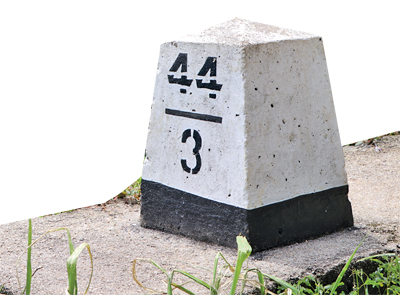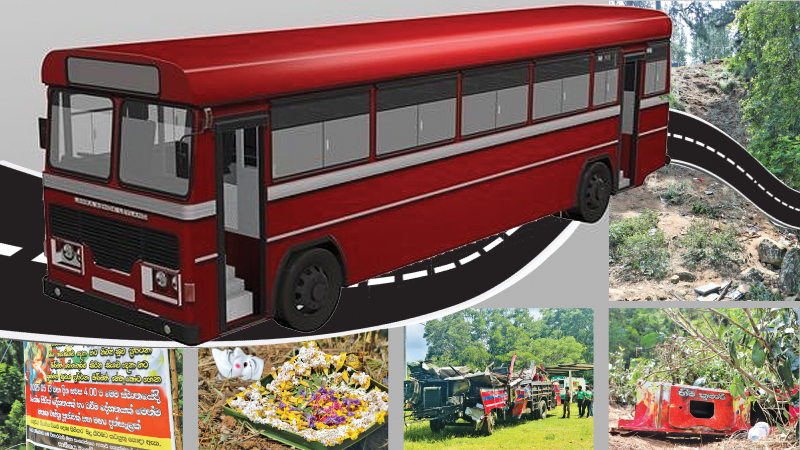On the early morning of May 11, 2025, a CTB bus travelling from Kataragama to Kurunegala veered off the Nuwara Eliya – Gampola main road in the Gerandi Ella – Ramboda, plunging into a deep ravine. The tragic accident resulted in the deaths of 23 people and left over 35 others injured.
 The crash happened on a dangerous part of the road, known for its sharp turns and steep slopes, about 23 kilometres from Nuwara Eliya. The injured were rushed to hospitals in Kotmale, Nuwara Eliya, Gampola, Nawalapitiya, and Peradeniya for treatment. After the accident, officials of the Department of Motor Traffic (DMT) inspected the bus, which is now kept at the Kotmale Police Station, to find out if the cause was a mechanical fault or a mistake by the driver.
The crash happened on a dangerous part of the road, known for its sharp turns and steep slopes, about 23 kilometres from Nuwara Eliya. The injured were rushed to hospitals in Kotmale, Nuwara Eliya, Gampola, Nawalapitiya, and Peradeniya for treatment. After the accident, officials of the Department of Motor Traffic (DMT) inspected the bus, which is now kept at the Kotmale Police Station, to find out if the cause was a mechanical fault or a mistake by the driver.
This incident has received a lot of attention, not just because of the lives lost, but also because of the false and confusing information that spread quickly on social media and news outlets. To uncover the truth, a Sunday Observer journalist visited the area and spoke to the police officers, hospital staff, ambulance services, local villagers, and victims. This report is based on those investigations and aims to give a clear and true account of the accident, while also examining the broader implications of misinformation in the digital age.
Police response: “A scene we can’t forget”
As our reporter entered the Kotmale Police Station, the weight of the recent tragedy was unmistakable. Nearby, a sombre collection of personal belongings, shoes, and passengers’ bags lay outside the OIC office, symbolic remnants of the journey that ended in catastrophe.
Although the OIC was away on urgent duties, officers at the station were willing to recount their first-hand experiences, though they requested anonymity due to ongoing inquiries. One officer who had been at the scene said:
“I took charge of the 21 bodies. We arrived at the location within 20 minutes of the call. It was still dark. Four of us went. I later proceeded to the hospital to handle the necessary protocols. What’s painful is not just the tragedy itself, but the stream of false accusations being made against us on social media. Many of us are still unable to eat after seeing what we saw that day.”
Another officer said with visible emotion:
“Reaching that spot is not an easy task. The bus plunged nearly 100 feet into a steep, dangerous valley. I carried an elderly woman, and she passed away in my arms. That scene is still in my eyes. While I was carrying that woman, someone was filming us with their phones instead of helping. It’s disgusting. The real heroes were the villagers and our fellow officers who risked their lives to save others.”
Over the phone, Chief Inspector Vajira Ratnayake, OIC of the Kotmale Police Station, detailed the timeline and operations carried out in the early hours of May 11.
“At 4.56 a.m., I received a call from a man in distress saying there had been an accident and people were screaming. I immediately despatched the PCD officer and our traffic OIC to the location and followed with another officer, arriving by 5.20 a.m. The first responding officer alerted me that the situation was serious, so I informed my senior officers and requested immediate assistance from nearby police stations, the STF, and the Army.”
According to Ratnayake, the accident site was not visible from the road, and the steep slope made the rescue operation extremely difficult.
“The slope was about 50 metres down. We couldn’t lift the victims to the road. Instead, we carried them to a Rambodagama primary school at the bottom of the slope. All the ambulances were brought there. Our team worked with the villagers, hospital staff, and other police units to transport the injured to the School, where they were then moved to hospitals.”
He strongly refuted allegations that the police delayed their response:
“People on the roadside didn’t know what was happening below. Ninety percent of them just took pictures and videos from above and posted baseless claims online. None of them saw the reality. The driver’s side of the bus was smashed against a rock, and people were trapped inside. We had to pull electric wires from nearby houses, cut metal seats, and pull people out through the iron. The villagers were incredible in helping us.”
“The driver was the last to be recovered. His body was pinned beneath the bus. Only after retrieving him did we conclude the rescue operation. Afterwards, I coordinated with the Poonduloya Depot to bring two SLTB recovery trucks and secured four more boom vehicles from local contacts to extract the wreck.”
“What’s being spread on social media is dangerous and false. It discredits the efforts of everyone who risked their lives to save others. We appeal for responsible reporting.”
 When contacted, the Police Media Spokesman, Senior Superintendent of Police Buddhika Manatunga, reinforced the official stance:
When contacted, the Police Media Spokesman, Senior Superintendent of Police Buddhika Manatunga, reinforced the official stance:
“Allegations that the police failed to act are completely false. We’ve verified the call logs and movement of the Kotmale Police OIC. The team arrived at the site within 20 minutes and acted swiftly. We are currently identifying the individuals who spread disinformation.”
1990 Suwa Seriya response: “We were there, even if they couldn’t see us”
Following the accident, the 1990 Suwa Seriya National Emergency Ambulance Service faced criticism on social media for an alleged delayed response. However, interviews conducted by our reporter with Suwa Seriya medical officers and corroborated by official statements reveal a different narrative.
On the day of the incident, the Kotmale Suwa Seriya ambulance was off duty. Nevertheless, the first ambulance from Nuwara Eliya arrived at the scene within 29 minutes of receiving the emergency call. Suwa Seriya Medical officers said that their vehicles were parked on the school grounds below the accident site, making them invisible to those on the main road above. This logistical decision was made to facilitate the easier transport of injured people down the slope, as bringing them up the steep terrain would have been more hazardous. Consequently, some onlookers and passersby mistakenly believed that no ambulances were present, leading to misinformation on social media platforms.
The official social media account of the 1990 Suwa Seriya service addressed these concerns, stating:
“On the morning of May 11, the 1990 Ambulance Service fulfilled its national mission with unwavering dedication. Despite the location being remote and difficult to access, the team reached the scene within 29 minutes of receiving the first emergency call, demonstrating an extraordinary commitment to swiftly transporting the injured to nearby hospitals. Given the high number of casualties, six ambulances from our Nuwara Eliya, Hatton, Udapussellawa, Gampola, Nawalapitiya, and Daulagala locations were immediately despatched to manage and support the emergency response in a coordinated effort.”
This was further confirmed by medical officers from the Kotmale Hospital, who acknowledged the timely arrival and critical assistance provided by the Suwa Seriya teams during the emergency. The discrepancy between the actual response and Social Media perception underscores the challenges faced by emergency services operating in difficult terrains and highlights the impact of misinformation during crisis situations.
The villagers: “we did everything we could to save lives”
At the police station, we met B. M. Chamara Senarath Bandara, a 41-year-old man from Gerandi Ella, who had come to the police station to give a statement about the accident. Chamara’s three-wheeler was the first to take the injured to the hospital.
“We rushed there as soon as we heard about the accident. We didn’t expect anything in return, we just wanted to save lives,” he said, “The bus was upside down, and even the heavy engine had crashed on top of the people. They were all trapped underneath. It rolled down the steep hill several times and landed in the middle of a cliff. We told the police and officers at the site, ‘You just take them to the hospital. We’ll do everything we can to save them. But it’s really painful to now see so much false criticism on social media. ”
Chamara’s friend, who was there, added that when they heard a loud crash, everyone ran to the scene immediately. “We’ve never experienced something so tragic in our lives. That scene still haunts me.”
Later, we visited the accident site ourselves.
From the top of the cliff, many people were standing and watching like it was a tourist spot, each telling their version of the story. We went down to the spot where the bus had fallen and realised how steep and dangerous the path was, even for someone young and strong.
A small stream and rows of tea bushes surrounded the area. When we crossed the stream, we saw a few small houses nearby. The injured and the dead were taken to the hospital through this same narrow path.
One elderly woman named, Chandrawathi, who lives near the site, said: “We heard a loud bang in the early morning. Then people screamed, ‘save us! save us!’ My son and daughter-in-law ran to help right away. We called every three-wheeler we knew. We gave everything, bedsheets, clothes, anything we had at home. We’ve never seen something like this before. I still hear the cries of those people in my ears.”
After the rescue, the villagers held a ‘thovila’ ritual above the site. They also went to the temple below to chant Pirith. Finally, we visited the small school that the Suwa Seriya team mentioned. One teacher told us that the ambulances and other vehicles were parked on the school grounds that day. From the school, the road goes directly to the A5 Gampola – Nuwara Eliya main road.
Kotmale hospital: “We did the best we could”
We then visited Kotmale Regional Hospital, which is near the new town – Kotmale. When we spoke to the hospital staff about the accident, we noticed that there was a lot of confusion caused by false news and social media rumours.
The hospital staff shared their side of the story:
“Our hospital doesn’t have many facilities, but we tried our best on that day,” one staff member said. Our shift usually starts at 7 a.m., but once we heard about the accident, we rushed to the hospital. All our staff came, and even some retired nurses showed up to help. Our mortuary can only hold two bodies, and that’s where we kept the people who died in the accident. We only have one ambulance, and it was already being used around 4.15 a.m. for someone who had a heart attack. The mother who went viral on social media was first brought here. We gave her saline, and she was able to speak to her children before being taken to Gampola Hospital,” they said. “Right now, none of the accident victims are in our hospital. We treated everyone and either sent them home or transferred the serious cases to the bigger hospitals. In a hospital, we only have one trolley to move patients. But it’s sad that after doing so much, people are still blaming us.”
Then we spoke to the Chief Medical Officer, Dr. H.S. Weeratunga, who said: “Some people said on social media that our hospital didn’t even have a single Paracetamol tablet. We didn’t respond online, but the truth is we had all the basic medicines. In fact, we had over 200,000 Paracetamol tablets in stock. We had saline, medicine to stop bleeding, and everything else needed for emergency care. This is all written in our audit report, which anyone can check. No one died because of a medicine shortage at our hospital. It was painful to hear people saying we had no medicine, because that’s simply not true” he said.
“All four of our doctors were present, including the one from the night shift. Some of us even went to the accident site to help. Other doctors and staff from nearby hospitals also joined us. We didn’t do this for attention, we did it because it’s our duty. The people in the village saw what we did, they know the truth,” he said.
“There was a delay in getting some patients to the hospital, but that was not our fault. The accident site was very hard to reach, and some people were trapped under the bus. The first patients arrived around 5.20 a.m., but more started coming only after 7 or 8 a.m. We didn’t stop working until midnight. That’s how committed our team was. But for us, it’s heartbreaking to see fake accusations after everything we’ve done,” he added.
What the expert says: “When there’s no truth, rumours win”
To better understand what happened on social media after the accident, we spoke to Dharshatha Gamage, a social media specialist and researcher.
He said, “Today, social media plays a huge role in how people get and share information. It’s easy to use, and information spreads very fast. Because of this speed, people rush to post things without checking if they’re true. Some people use social media to become popular. They want their posts to go viral to get more likes and shares, so they post without thinking. In the past, rumours were only shared between a few people. But now, those same rumours can reach thousands or even millions because of social media,” he said.
Also, he said, “Many people are posting their opinions online after something happens and treating them like facts. This used to be something small, but now it can grow into a national-level issue. We also need to ask whether traditional media is doing its job properly. Are they fact-checking? Are they taking the time to find the truth? Since traditional media is constantly reporting, there’s no one checking them either. So the real question is who is responsible for giving people the truth?”
Dharshatha said, “To avoid these problems, official sources like the police, health services, and other authorities must improve how they communicate. When they don’t share clear and timely information, people fill the silence with rumours. If there’s no proper communication system, people will believe anything they see online.”
The silence that fed the rumours
What happened in Kotmale is more than just a tragic accident. It is also a case study of how misinformation can grow when the truth is missing. When official institutions stay silent or take too long to respond, social media fills the gap, often with half-truths, guesses, or deliberate lies. The staff at the Kotmale Hospital did their best with limited resources. Yet, their efforts were buried under a flood of false claims. Rumours about a lack of medicine or late response spread like wildfire, even though they weren’t true.
As Dharshatha said, when there’s no reliable flow of official information, people will believe whatever is loudest online. And in this case, that noise created confusion, mistrust, and pain. If we are to prevent such situations in the future, we must fix how our institutions talk to the public. Hospitals, police, and emergency services need to respond faster, more clearly, and with facts. And as citizens, we must also pause before we share because behind every post, there are real people who could be hurt by what we say.
Truth is not just a fact, it’s a responsibility. And we all have a part in protecting it.







